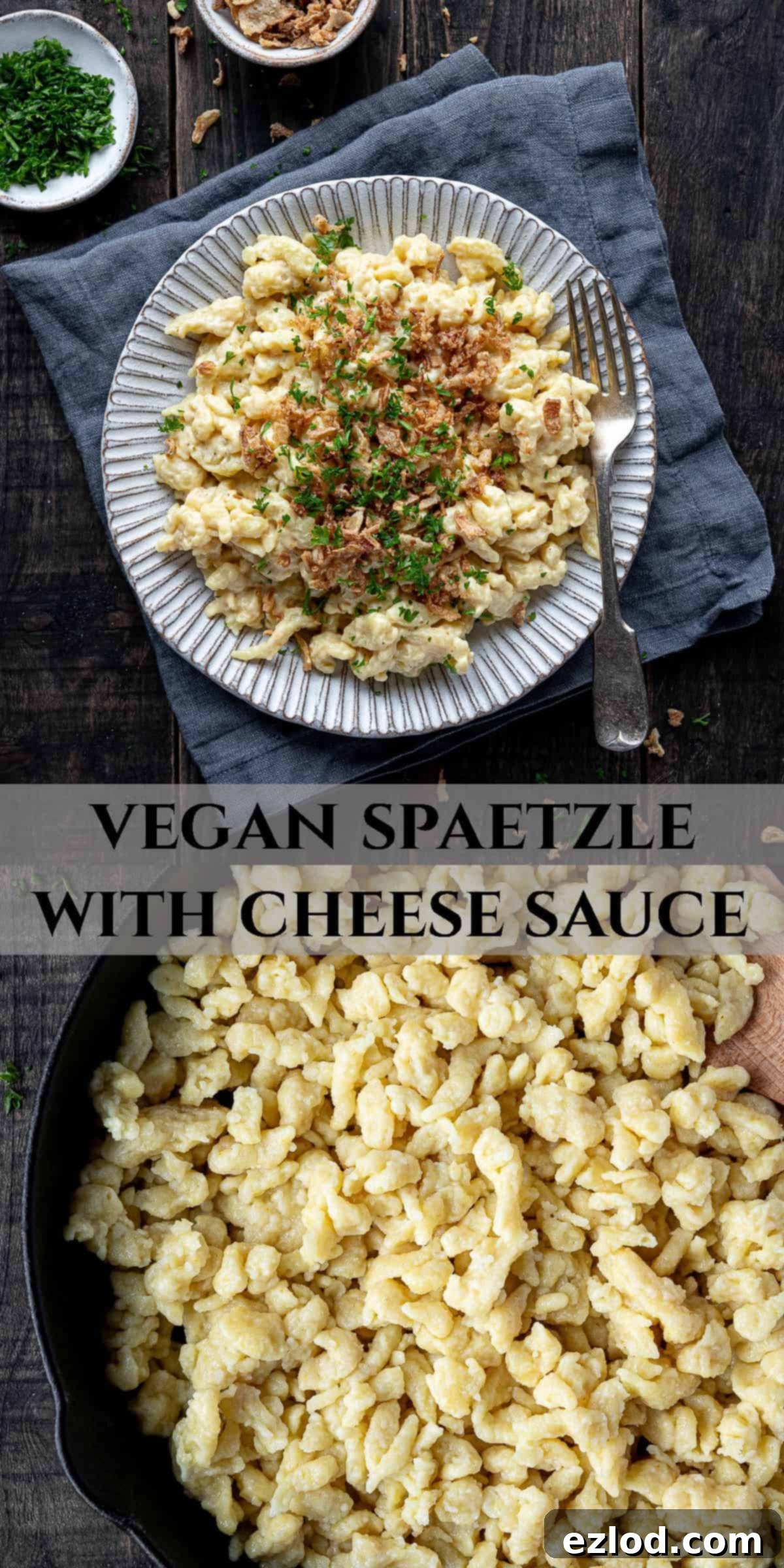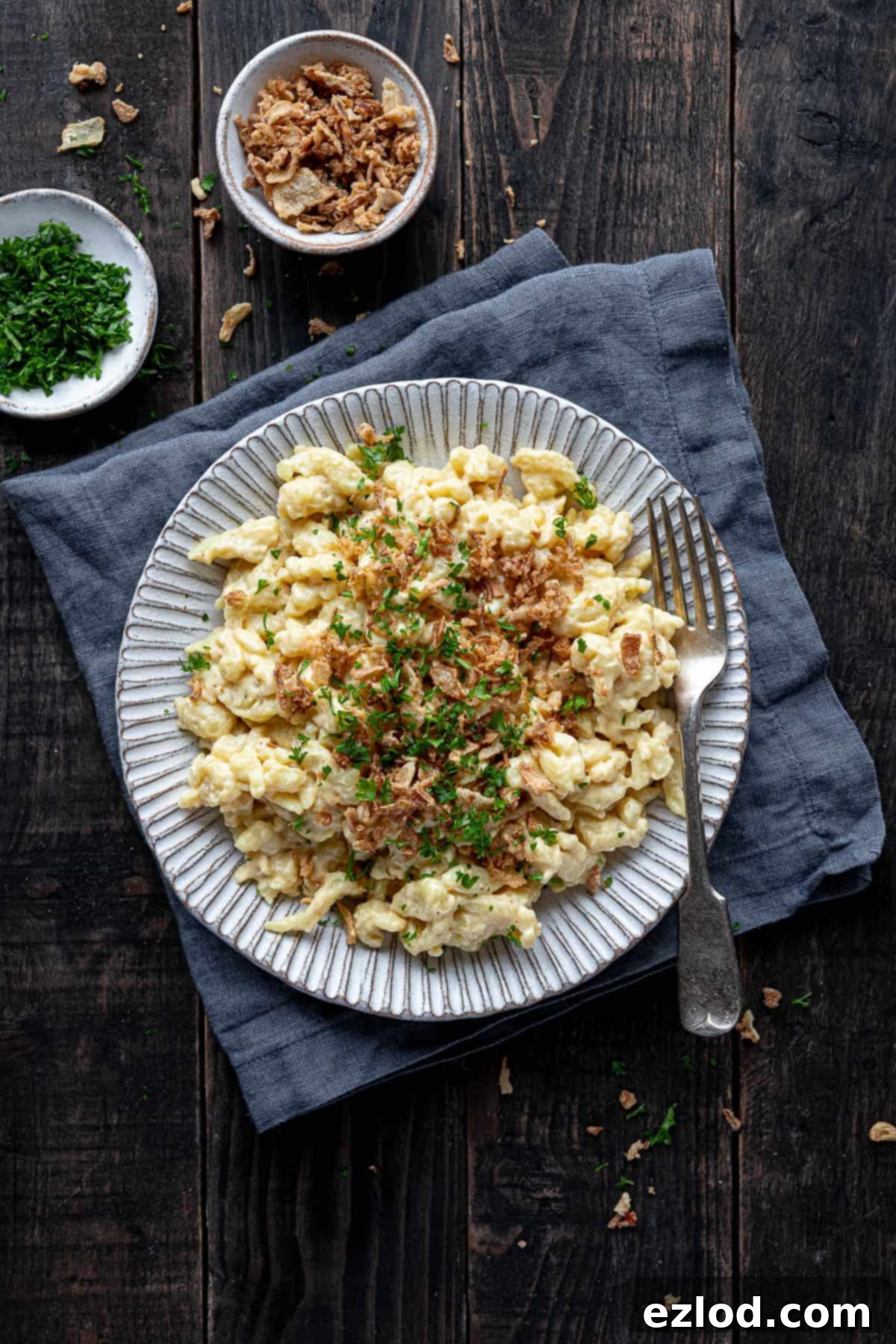Delicious Vegan Spaetzle: Easy Eggless German Noodle Dumplings with Homemade Cheese Sauce
Craving a hearty, comforting meal that transports you straight to a German kitchen, but without any animal products? Look no further! Our incredible Vegan Spaetzle recipe delivers all the tender, chewy goodness of traditional German noodle dumplings, made entirely egg-free and dairy-free. This isn’t just a meal; it’s a warm hug in a bowl, ready to satisfy your deepest comfort food desires in under 20 minutes of active preparation.
Imagine perfectly formed, soft yet firm spaetzle, generously coated in a rich, creamy homemade vegan cheese sauce, and crowned with crispy fried onions. This culinary masterpiece is not only surprisingly quick and easy to make from scratch, but it also elevates a classic dish into a plant-based delight suitable for everyone. Whether you’re a seasoned vegan or simply exploring delicious meat-free options, this recipe promises an authentic taste experience that’s both satisfying and utterly delicious.
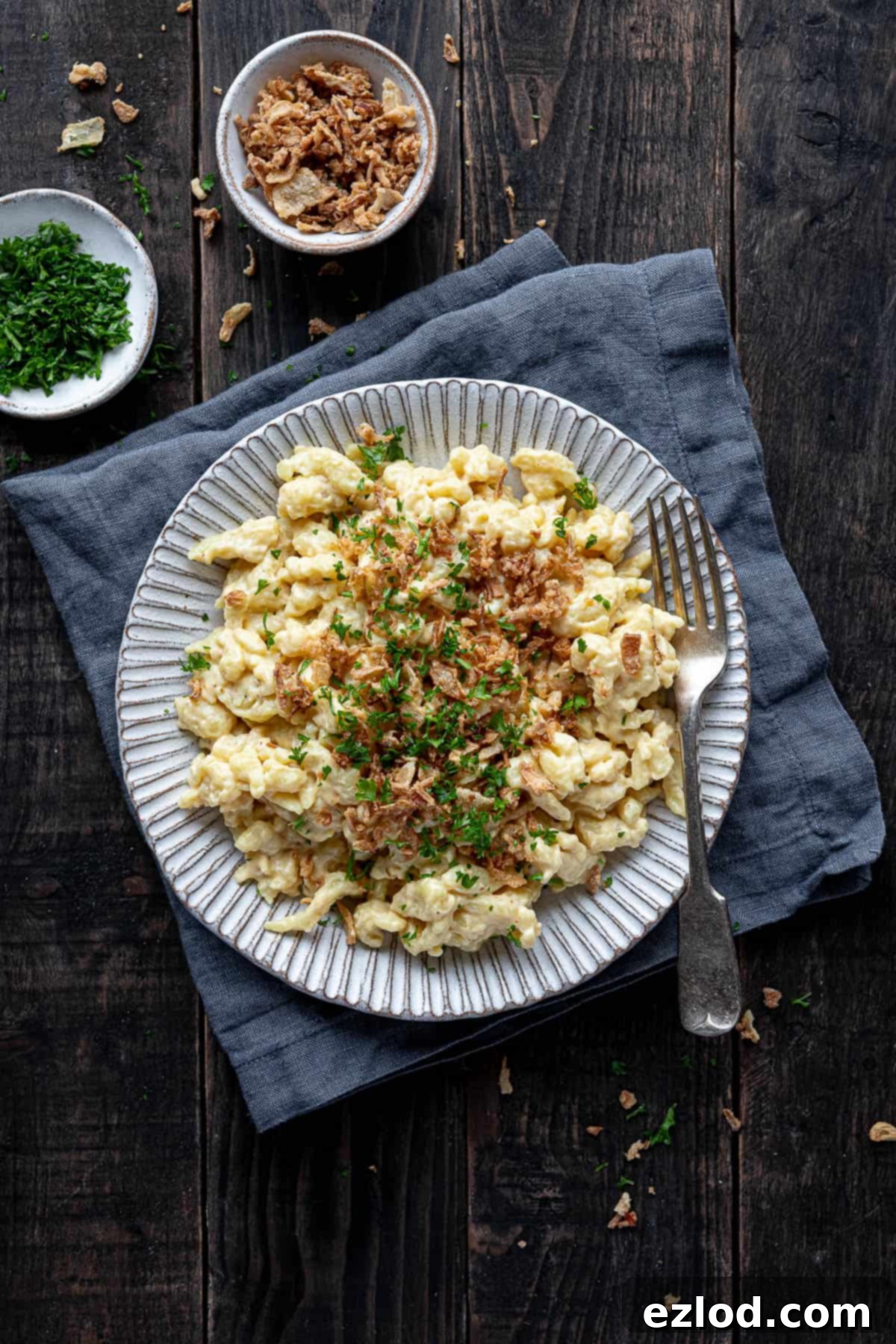
What Are Spaetzle? A Beloved German Comfort Food
Spaetzle (pronounced “shpeht-zluh”) are a distinctive type of soft egg noodle or dumpling, widely regarded as a staple in Southern German cuisine. While most commonly associated with regions like Swabia in Germany, they are also a cherished culinary tradition across Austria, Switzerland, Alsace (France), and parts of Hungary. These delightful dumplings are characterized by their irregular, often short and plump, shape and their wonderfully chewy texture, which makes them incredibly versatile. Traditionally, spaetzle are made from a simple batter of flour, eggs, and often milk or water, then either pressed or scraped directly into boiling water.
They can be served in numerous ways: as a simple side dish to hearty stews and roasts, pan-fried until golden with butter and herbs, or as the star of a main course like Käsespätzle (cheese spaetzle), which is the inspiration behind our vegan version. The very name “spaetzle” is thought to derive from “Spatzen,” meaning little sparrows, due to their small, irregular shape when hand-scraped, or “Spätzle-Press” referring to the tool used to make them.
The Vegan Spaetzle Challenge: Crafting Eggless Perfection
Veganizing a dish so fundamentally reliant on eggs, as traditional spaetzle is, presents a unique challenge. Eggs typically contribute significantly to the dough’s structure, binding, and characteristic chewy texture. My initial attempts at creating eggless spaetzle involved experimenting with chickpea flour as an egg replacer, a common tactic in vegan baking. However, this yielded a result that was disappointingly gluey and heavy, lacking the desired lightness and bite of authentic spaetzle.
After further research and testing, I discovered that many successful vegan spaetzle recipes online ingeniously replace eggs with a combination of fine semolina flour and starch. This approach proved to be a game-changer! Semolina, widely used in pasta making, provides the necessary structure and a delightful al dente chew, while potato or corn starch acts as an excellent binder and helps achieve that signature soft yet resilient texture. This recipe is a culmination of extensive experimentation and draws inspiration from various successful vegan adaptations, ensuring a truly delicious and authentic-tasting egg-free German noodle dumpling that you’ll absolutely love.
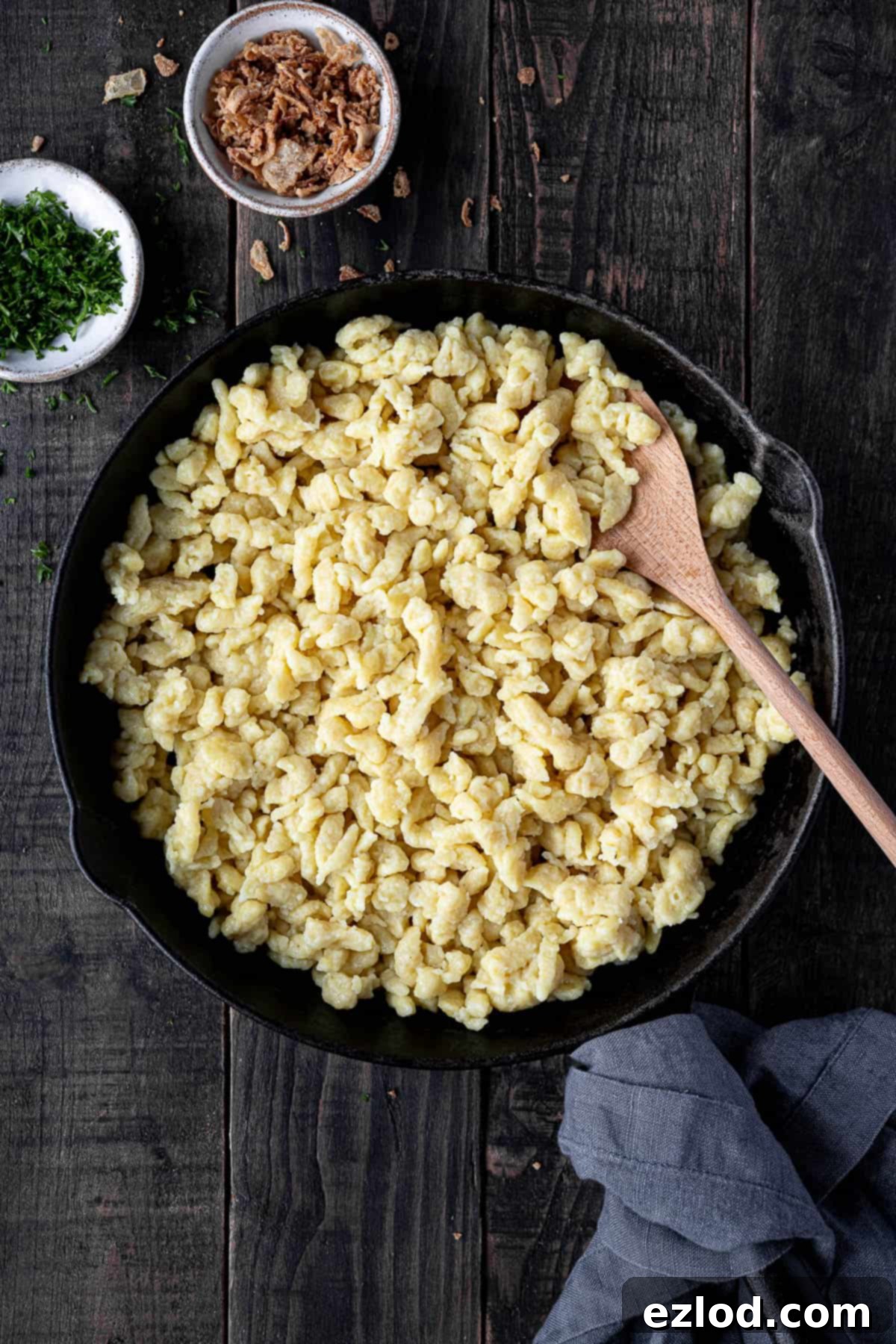
Essential Tools for Making Perfect Vegan Spaetzle
While traditionalists might advocate for the freehand scraping method, using a dedicated spaetzle maker is by far the easiest and most consistent way to produce these German noodle dumplings. The type of maker you choose will influence the shape and texture of your spaetzle, offering a slight variation in your final dish. Here are the three main types you might encounter:
- Potato Ricer Style Spaetzle Press: This device operates much like a potato ricer. You fill the cylinder with dough and press it through small holes directly into the boiling water. This method typically produces longer, more noodle-like spaetzle, perfect if you prefer a shape akin to thin pasta.
- Spaetzle Maker Pan Lid with Scraper: This is the style I personally use and highly recommend for its ease and the delightful shape it creates. It consists of a perforated plate that sits over your pot of boiling water, and a small batter box or ‘sled’ with a scraper. You pour the batter into the box and slide it back and forth over the holes, allowing the dough to fall into the water. This produces short, button-shaped spaetzle, often referred to as Knöpfle.
- Grater Shaped Board with Pusher: This is arguably the most traditional hand-scraping method, albeit with a helpful tool. You place a special board with holes over the boiling water, spread the dough onto it, and use a pusher or scraper to force small portions through the holes. This method also results in short, irregularly shaped spaetzle, similar to the pan lid style, but with a more rustic appeal.
If you don’t have a dedicated spaetzle maker, you can still make these dumplings! The original, most rustic method involves simply scraping small pieces of dough off a wooden cutting board directly into the boiling water using a knife. This requires a bit of practice to get consistent shapes, so I suggest watching a few online video tutorials if you opt for this traditional technique.
Key Ingredients for Our Eggless Spaetzle Dough
Creating delicious vegan spaetzle relies on a careful selection of ingredients that mimic the texture and richness of their egg-based counterparts. Here’s a breakdown of what you’ll need for the dough:
- Plain (All-Purpose) Flour: This forms the base of our spaetzle dough. Standard plain or all-purpose flour works perfectly, providing the necessary structure without being too heavy. I haven’t tested this recipe with gluten-free flours or other specialty flours, so for best results, stick with regular wheat flour.
- Fine Semolina Flour: This is arguably the most crucial ingredient for achieving the authentic spaetzle texture without eggs. Semolina, made from durum wheat, is what gives pasta its characteristic chew and firm structure. It provides a wonderful “bite” to the dumplings. Ensure you use *fine* semolina; if you can only find coarse semolina, you can pulse it briefly in a high-powered blender or food processor to achieve a finer consistency. There is no direct substitute for semolina in this recipe, as it plays such a vital role.
- Potato or Corn Starch: Acting as a binder and helping with the tender texture, either potato starch or corn starch will work well. I personally lean towards potato starch for a slightly softer finish, but feel free to use whichever you have on hand. If you prefer, you can also substitute this entirely with an equal amount of additional fine semolina flour for an even chewier dumpling.
- Unsweetened Non-Dairy Milk: Any unsweetened plant-based milk can be used to hydrate the dough. Soy milk is my preferred choice due to its neutral flavor and good protein content, which can subtly contribute to the dough’s structure. Almond, oat, or cashew milk would also work, just ensure they are plain and unsweetened.
- Oil: A touch of olive oil (or another neutral vegetable oil) adds a richness to the dough, replacing the fat that would typically come from egg yolks. It also helps to keep the spaetzle tender and prevents them from becoming too sticky.
- Baking Powder: Just a small amount of baking powder helps to provide a slight lift and lightness to the eggless dough, counteracting any potential heaviness and contributing to a more tender finished product. While optional, it’s recommended for the best texture.
- Salt: Essential for flavour, salt enhances all the other ingredients in the dough.
- Turmeric (Optional): For that classic golden-yellow hue of traditional egg spaetzle, a tiny pinch of turmeric does the trick without impacting the flavour. It’s purely for visual appeal, so you can easily omit it if preferred.
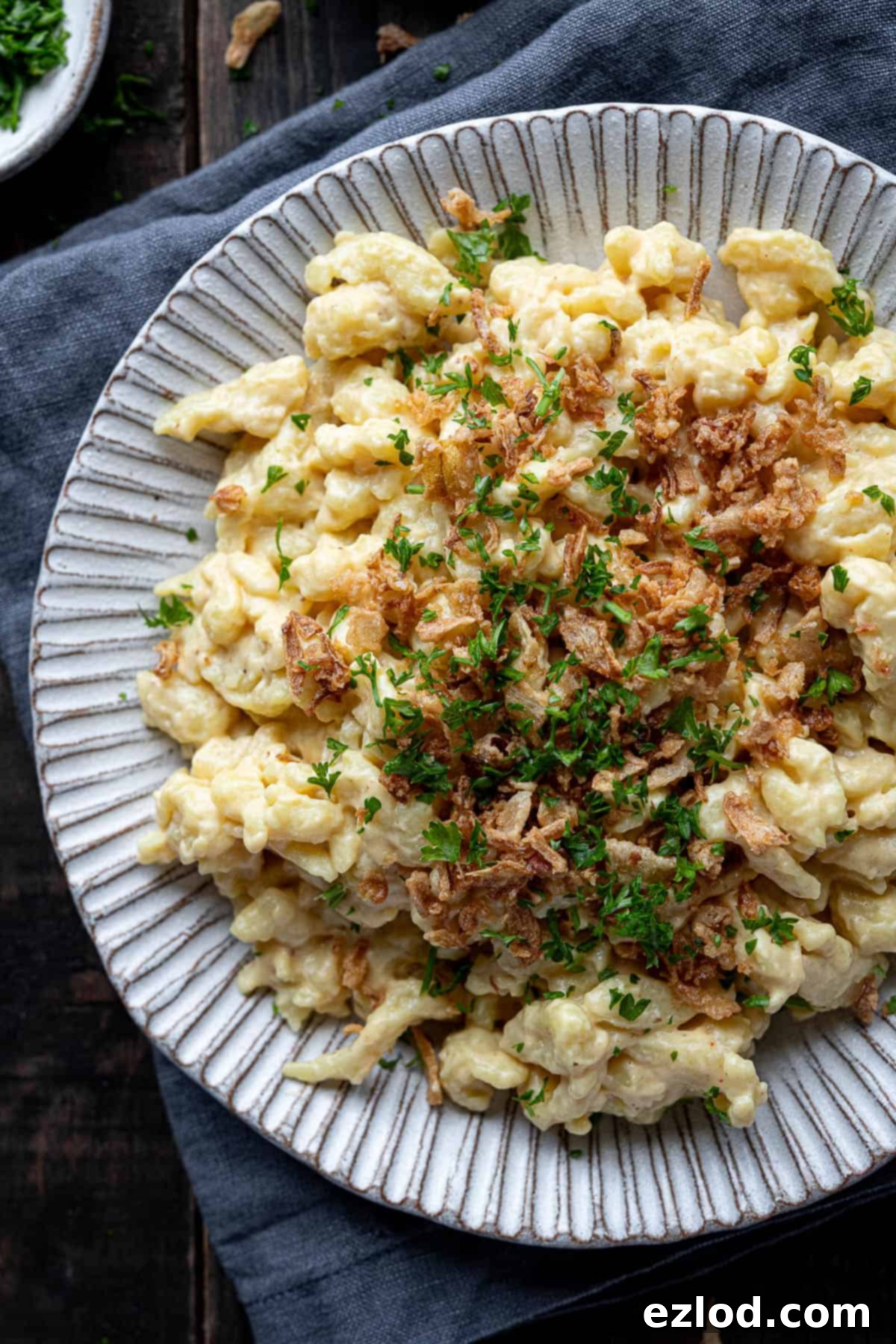
How To Make Delicious Vegan Spaetzle: A Step-by-Step Guide
Making vegan spaetzle is a straightforward process that comes together quickly, allowing you to enjoy this German comfort food in no time. Follow these steps for perfectly tender, chewy eggless dumplings and a creamy, homemade cheese sauce:
1. Prepare the Spaetzle Dough
Begin by combining all the dry ingredients for the spaetzle dough in a large mixing bowl: the plain flour, fine semolina, potato or corn starch, salt, baking powder, and the optional turmeric for color. Whisk them together thoroughly to ensure they are well combined and evenly distributed.
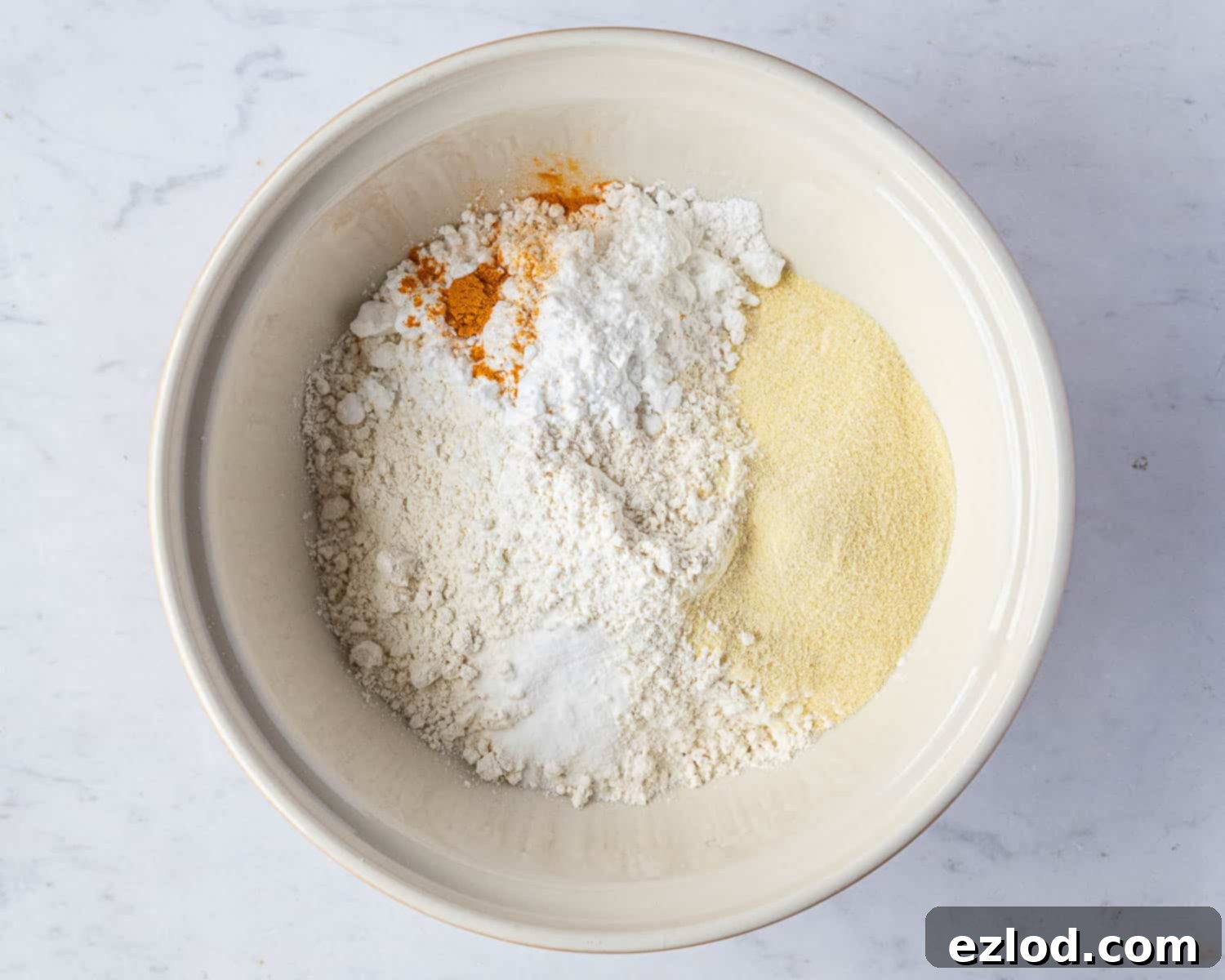
Next, add the olive oil to the dry mixture. Gradually pour in the unsweetened non-dairy milk, starting with about 500ml (2 cups). Using a whisk or a wooden spoon, mix everything until a thick, smooth batter forms. The consistency should resemble that of a thick pancake batter – not too runny, but easily pourable or scoopable. Beat the batter vigorously for a few minutes; this helps to develop the gluten in the flour and introduces air, which contributes to a lighter texture. You’ll notice small bubbles forming, indicating the batter is ready. If the batter seems too stiff, add the remaining 50ml (¼ cup) of milk incrementally until the desired consistency is achieved.
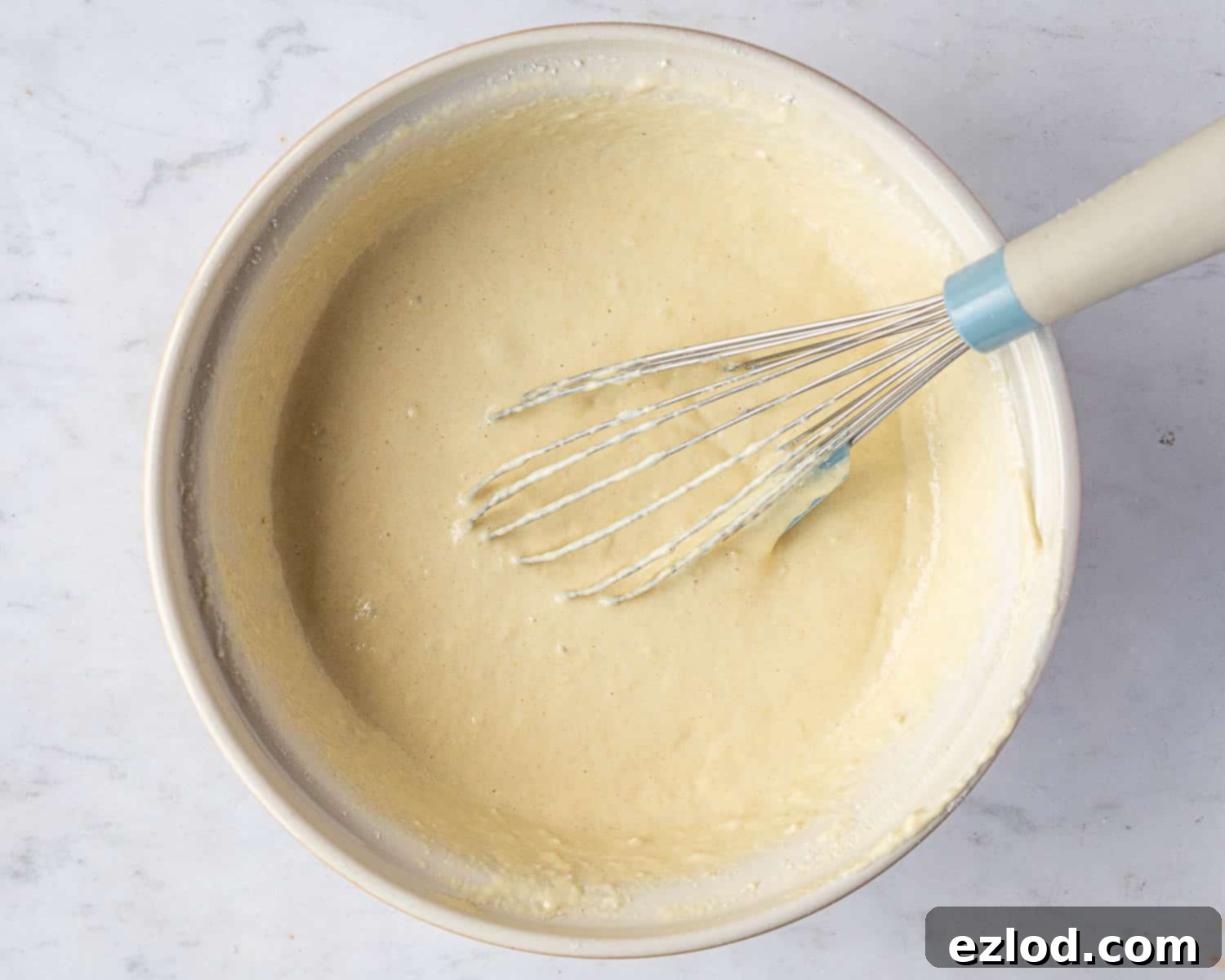
2. Cook the Spaetzle
Bring a large pot of salted water to a rolling boil. Once boiling, reduce the heat slightly to maintain a gentle boil. This prevents the spaetzle from breaking apart as they enter the water. Now, it’s time to cook your spaetzle using your chosen method.
If you’re using a spaetzle press (like the potato ricer style), simply scoop a portion of the batter into the press and push it directly into the boiling water. For a pan lid style maker with a scraper, place the perforated plate over your pot, scoop a portion of batter onto the ‘sled,’ and slide it back and forth to scrape the dough through the holes into the water below.
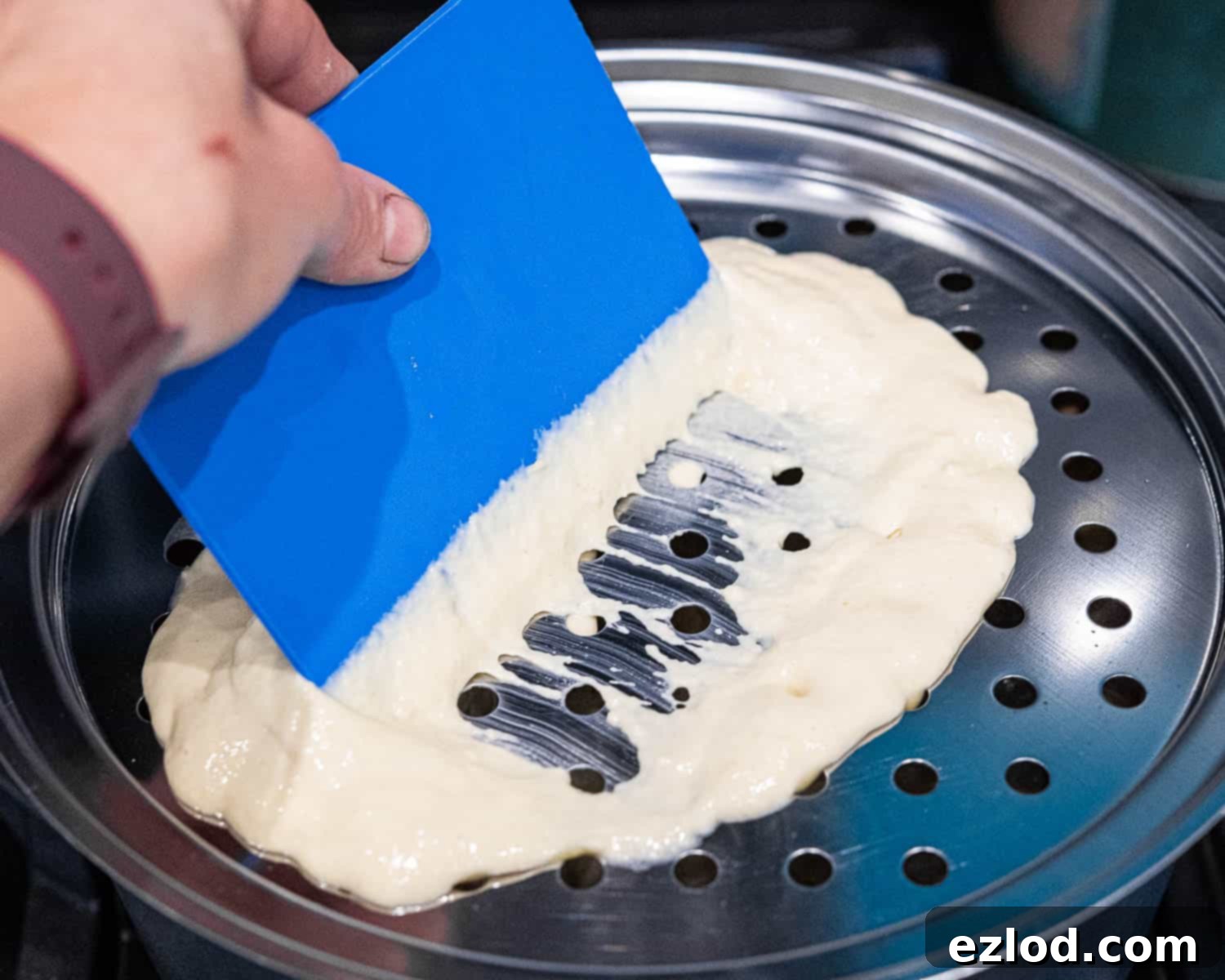
Cook the spaetzle in batches to avoid overcrowding the pot, which can lower the water temperature and result in gummy dumplings. The spaetzle will cook very quickly, usually within 1-2 minutes. Once they float to the surface, they are cooked through.
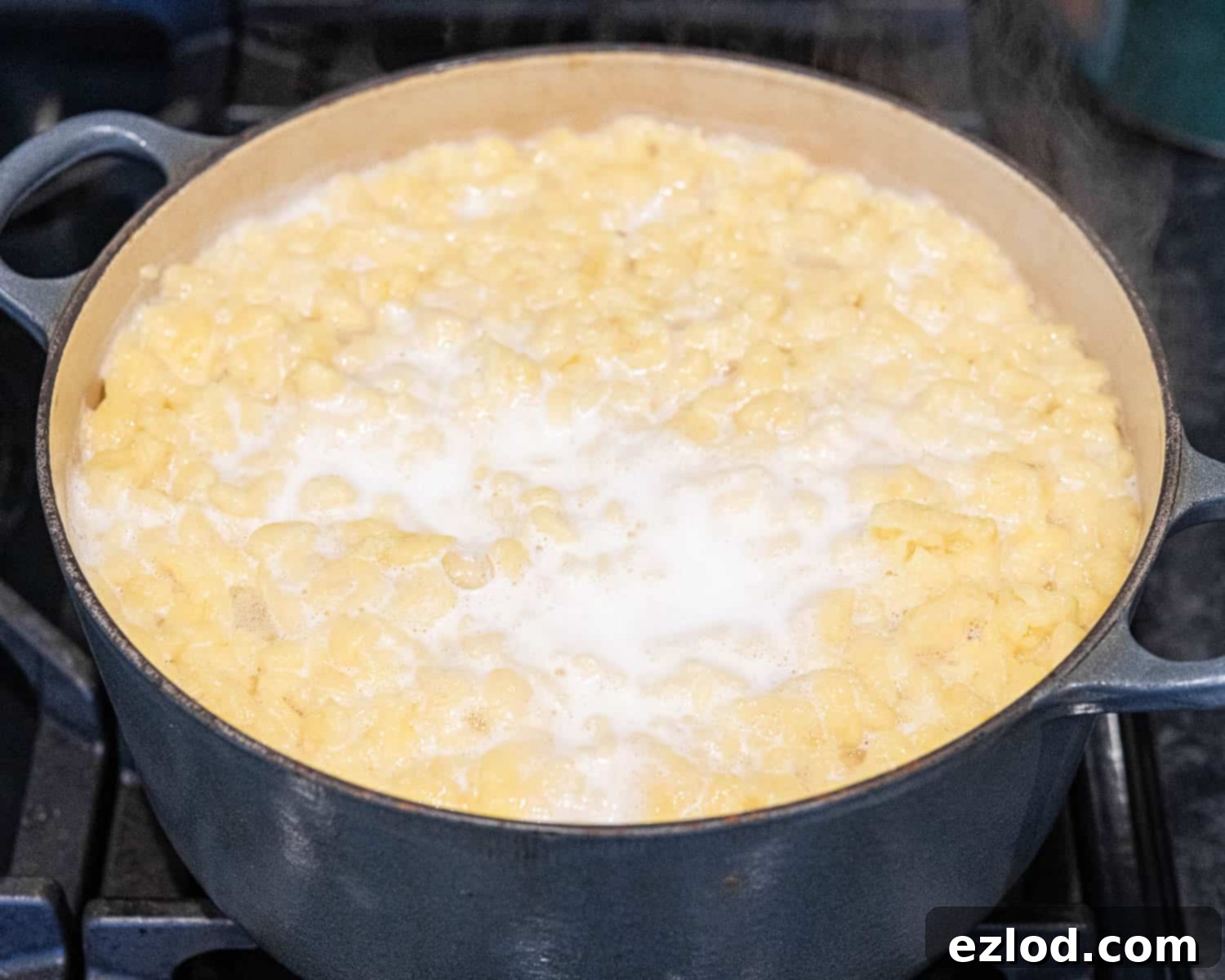
Using a slotted spoon, carefully skim the cooked spaetzle from the water and transfer them to a colander. Rinse them briefly with cold water to prevent them from sticking together and to stop the cooking process. Allow them to drain thoroughly before proceeding. Repeat this process with the remaining batter until all the spaetzle are cooked.
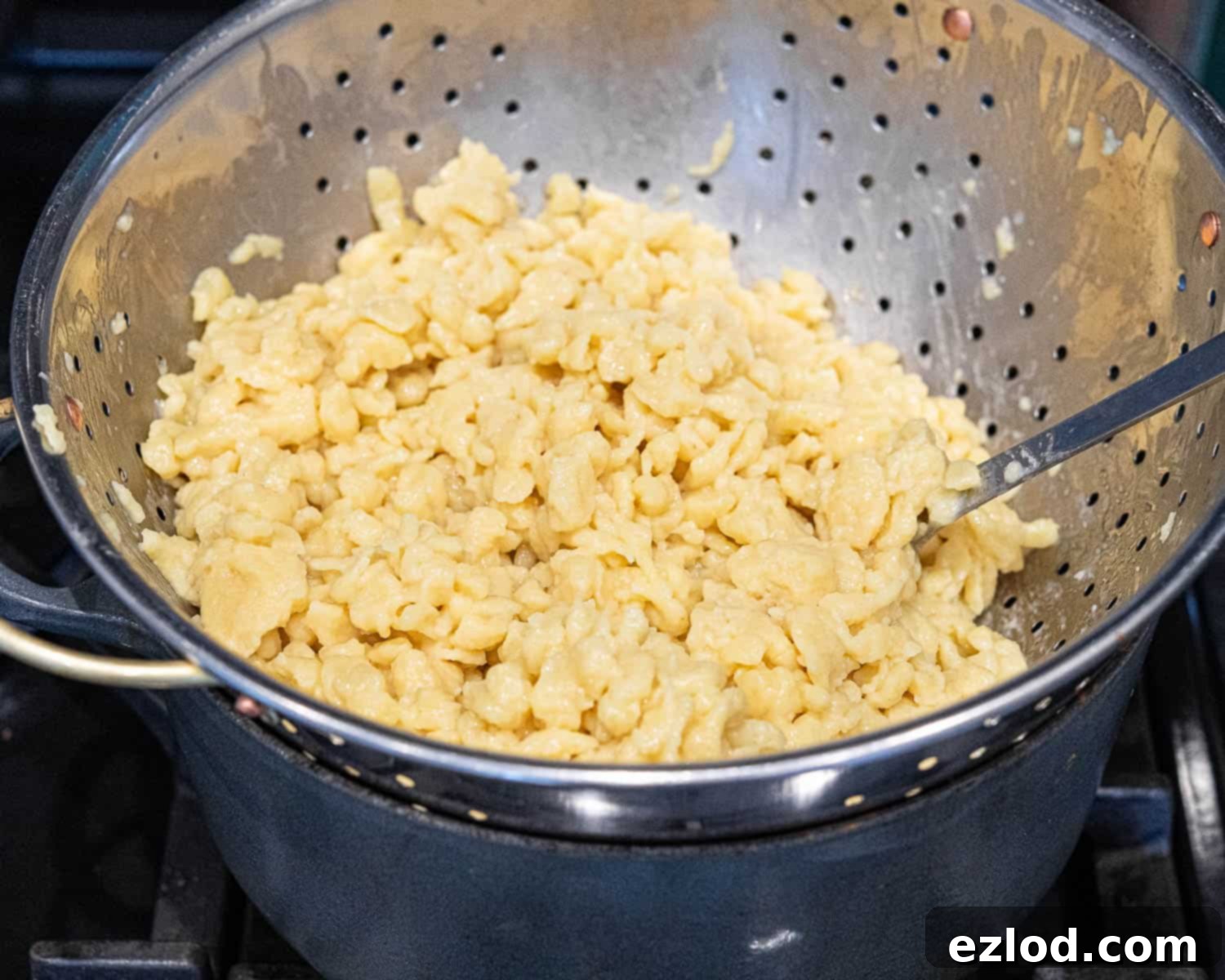
3. Prepare the Creamy Vegan Cheese Sauce
Our homemade vegan cheese sauce is the perfect accompaniment to the spaetzle, offering a rich, savory, and wonderfully “cheesy” flavor without any dairy. Begin by peeling and dicing a large potato and slicing a medium carrot. Boil these vegetables along with the cashews in water until they are very soft and easily pierced with a fork. This ensures a smooth, creamy sauce.
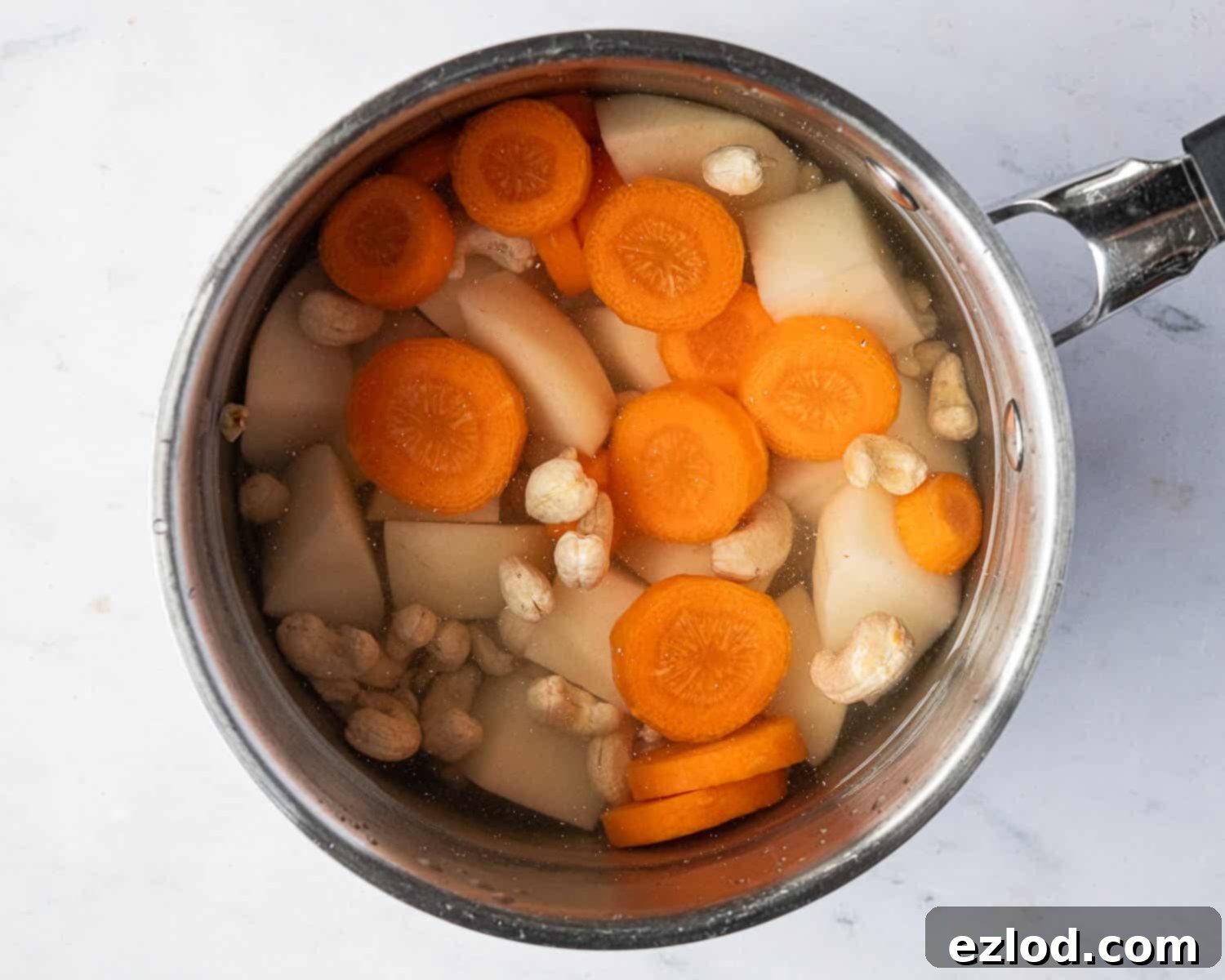
Once soft, drain the potato, carrot, and cashews thoroughly. Transfer them to a high-speed blender. Add the remaining cheese sauce ingredients: a stock cube (or vegetable bouillon powder), nutritional yeast (essential for that cheesy flavor), salt, wholegrain mustard, lemon juice, garlic powder, onion powder, smoked paprika, olive oil, and the unsweetened non-dairy milk. Blend on high until the sauce is completely smooth and creamy, without any lumps. Taste and adjust seasonings as needed, adding more salt, nutritional yeast, or lemon juice to your preference.
Serve your freshly cooked vegan spaetzle immediately, tossed with the warm cheese sauce and a generous sprinkle of crispy fried onions for an unforgettable comfort food experience!
Top Tips for Perfect Vegan Spaetzle Every Time
- Accurate Measurements are Key: For the most consistent and best results, I highly recommend using a digital kitchen scale for metric measurements rather than relying on imprecise cup conversions. Baking and noodle-making are scientific, and accurate ratios make a huge difference in texture.
- Don’t Overcrowd the Pot: Cook the spaetzle in batches. Dropping too much dough into the boiling water at once will significantly lower the water temperature, leading to sticky, gummy spaetzle instead of light, tender ones.
- Rinse After Cooking: A quick rinse under cold water after cooking is crucial. This not only stops the cooking process but also washes away excess starch, preventing the spaetzle from sticking together. Ensure they are well-drained afterwards.
- Achieving “Egg” Flavor: For those who miss the subtle “eggy” flavor, a tiny pinch of kala namak (Indian black salt) added to the dough can introduce a sulfurous note that mimics egg remarkably well. Add it to taste.
- Batter Consistency: The batter should be thick but still pourable. If it’s too thin, your spaetzle will be too soft and might dissolve. If it’s too thick, it will be hard to press through the maker. Adjust with a little more flour or milk as needed.
- Serve Immediately: While spaetzle can be reheated, they are always best fresh, straight from the pot, lightly pan-fried, and mixed with your sauce of choice.
Can I Make Vegan Spaetzle in Advance?
Absolutely! Cooked vegan spaetzle can be prepared ahead of time, making meal prep a breeze. Store the cooled spaetzle in an airtight container in the refrigerator for up to 5 days. When ready to serve, reheat them gently in a non-stick pan with a little vegan butter or oil, stirring occasionally until warmed through and slightly golden. You can also microwave them, though pan-frying yields a better texture.
Can I Freeze Vegan Spaetzle?
Yes, vegan spaetzle freezes beautifully! After cooking, rinse the spaetzle with cold water and ensure they are thoroughly drained. Spread them out in a single layer on a baking tray lined with parchment paper and freeze until solid. Once frozen, transfer the spaetzle to a freezer-safe bag or container, where they can be stored for up to 3 months.
To reheat from frozen, there’s no need to defrost! Simply transfer the frozen spaetzle directly into a pot of boiling water and cook for a few minutes until they are heated through. Alternatively, you can toss them directly into a hot pan with a bit of oil or vegan butter and pan-fry until golden and warmed.
How to Serve Vegan Spaetzle: Versatile & Delicious
The beauty of vegan spaetzle lies in its versatility. While my favorite way to enjoy them is smothered in homemade vegan cheese sauce and topped with crunchy crispy fried onions (which you can often find pre-made at your local supermarket), there are many other delightful serving options:
- As a Side Dish: They make an excellent alternative to pasta or potatoes alongside almost any meal. Simply toss them with a generous knob of melted vegan butter and a sprinkle of fresh parsley or chives.
- Pan-Fried: For an extra layer of flavor and texture, pan-fry the cooked spaetzle in a little vegan butter or oil until they are golden brown and slightly crispy. This is particularly delicious with a sprinkle of herbs.
- With Gravy or Stews: Pair them with a rich mushroom gravy, a hearty vegan goulash, or a comforting lentil stew for a truly satisfying meal.
- In Salads: Cooled spaetzle can be a unique addition to cold pasta salads, adding a chewy element.
- Sweet Applications: While less common for this specific recipe, some spaetzle varieties are served sweet with fruit or sugar.
More Vegan Comfort Food Recipes to Love:
- Vegan chilli cornbread pie
- Vegan Swedish meatballs
- Chickpea, leek and mushroom pie
- Vegan pasta bake
- Vegan cottage pie
- Creamy vegetable rice soup
- Vegan mushroom stroganoff
- Vegan chicken potato pie
- Vegan lentil walnut bolognese
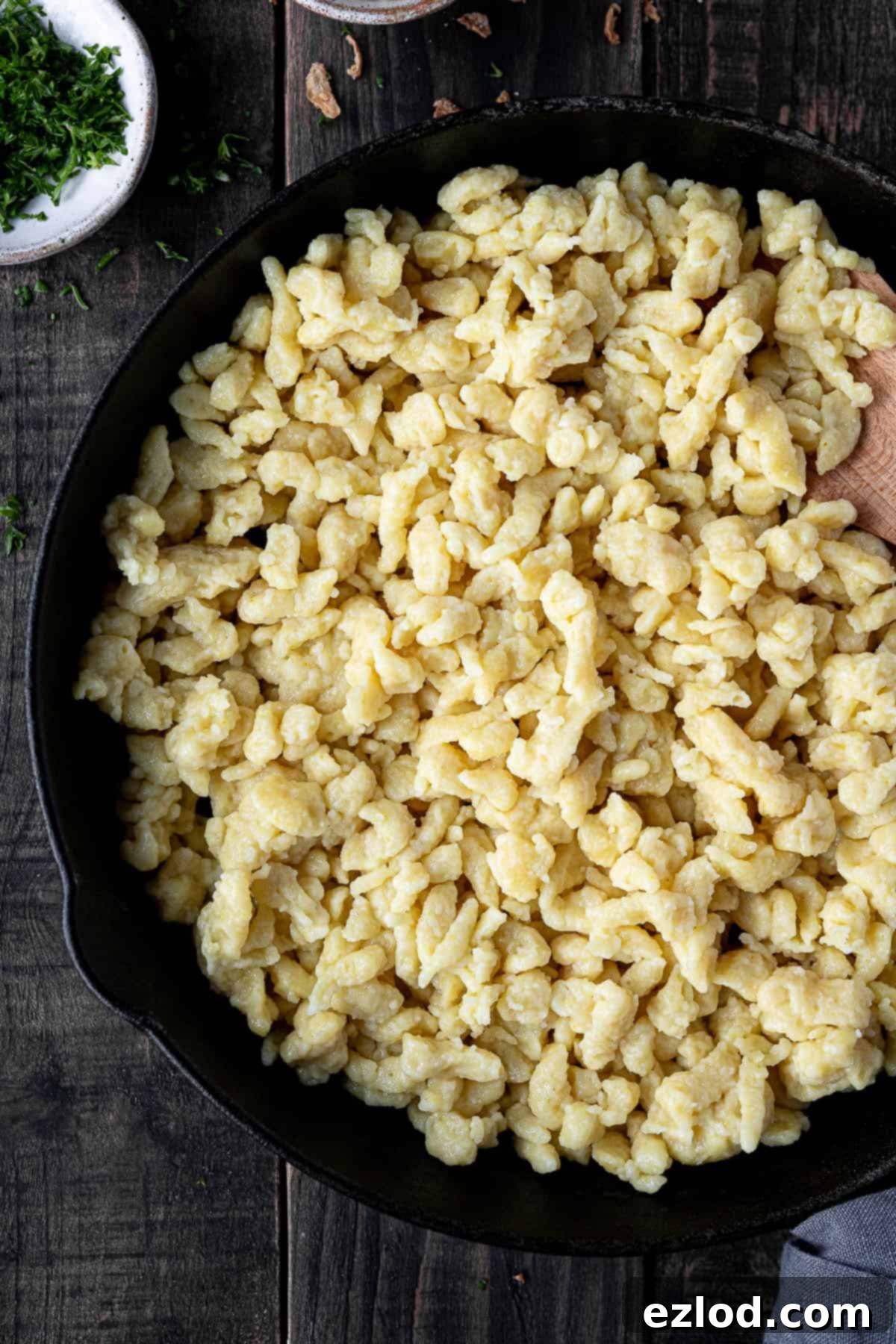
We hope you love this delicious Vegan Spaetzle recipe! If you tried it, please let us know how it went by leaving a rating and comment below. You can also tag @domestic_gothess on Instagram and use the hashtag #domesticgothess to share your creations. Your feedback helps us and others discover fantastic new recipes!
All images and content on Domestic Gothess are copyright protected. If you wish to share this recipe, please do so by using the provided share buttons or by including a link back to this original post. Kindly refrain from screenshotting or reposting the recipe or its content in full.

Vegan Spaetzle with Creamy Cheese Sauce
Ingredients
For the Vegan Spaetzle:
- 375 g (3 cups) plain (all-purpose) flour
- 70 g (5 ½ Tablespoons) fine semolina flour
- 40 g (4 packed Tablespoons) potato or corn starch (or use more semolina for a chewier dumpling)
- 1 teaspoon salt
- ¼ teaspoon baking powder (optional, for added lightness)
- ⅛ teaspoon turmeric (optional, for color)
- 2 Tablespoons olive oil
- 500-550 ml (2 – 2 ¼ cups) unsweetened non-dairy milk (soy milk recommended)
For the Creamy Vegan Cheese Sauce:
- 250 g potato (1 large) (peeled and cut into chunks)
- 1 medium carrot (sliced)
- 70 g (½ cup) raw cashews
- 1 vegetable stock cube (or bouillon powder)
- 4 Tablespoons nutritional yeast
- ½ teaspoon salt
- 1 teaspoon wholegrain mustard
- 1 Tablespoon lemon juice
- 1 teaspoon garlic powder
- 1 teaspoon onion powder
- ¼ teaspoon smoked paprika
- 1 Tablespoon olive oil
- 250 ml (1 cup) unsweetened non-dairy milk (soy milk recommended)
Instructions
-
In a large bowl, whisk together plain flour, fine semolina, potato or corn starch, salt, baking powder (if using), and turmeric (if using).
-
Add the olive oil and gradually whisk in 500ml (2 cups) of non-dairy milk. Continue whisking vigorously for a few minutes until the batter is smooth, thick like pancake batter, and bubbles begin to form. Add the remaining 50ml milk only if needed to reach the desired consistency.
-
Bring a large pot of salted water to a boil. Reduce heat to a gentle boil. Scoop some batter into your spaetzle maker (press, pan lid with scraper, or grater board) and press or scrape the spaetzle directly into the boiling water.
-
Cook in batches (1-2 minutes per batch) until the spaetzle float to the top. Using a slotted spoon, remove them and transfer to a colander. Rinse briefly with cold water to prevent sticking, and drain well. Repeat with the remaining batter.
-
For the cheese sauce: Boil the chopped potato, sliced carrot, and cashews until very soft. Drain thoroughly.
-
Transfer the boiled vegetables and cashews to a high-speed blender. Add the stock cube, nutritional yeast, salt, wholegrain mustard, lemon juice, garlic powder, onion powder, smoked paprika, olive oil, and non-dairy milk. Blend until completely smooth and creamy. Taste and adjust seasonings as desired.
-
Serve the warm vegan spaetzle immediately, coated with the creamy cheese sauce and topped with crispy fried onions. Enjoy!
Notes
- For detailed tips, ingredient information, and step-by-step photos, please refer to the main article above.
- Using a digital kitchen scale for metric measurements is highly recommended for accurate and consistent results in this recipe.
